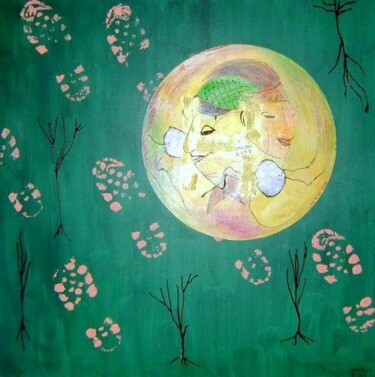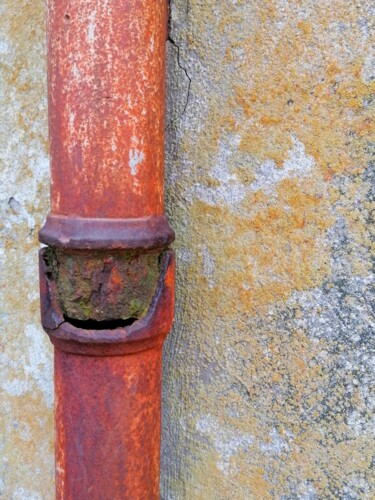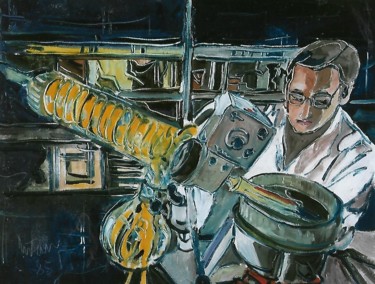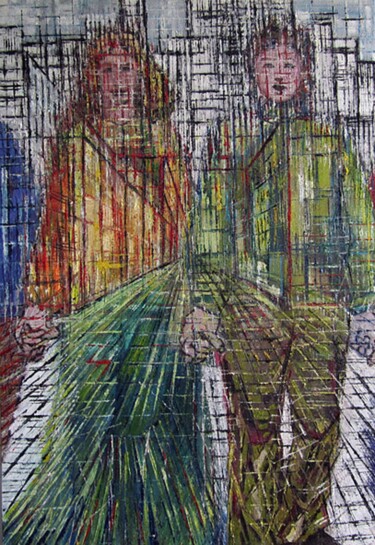
7 Originele kunstwerken, limited editions en prints:
Land art, ook wel earth art genoemd, ontstaat direct in het landschap door het te boetseren of door er natuurlijk-materiële structuren op te bouwen. Het begin van de milieubeweging en de wijdverbreide commoditisering van Amerikaanse kunst eind jaren zestig hadden een impact op ideeën en werken die in verschillende mate vervreemd waren van de kunstmarkt. De beweging was een ontwikkeling van het conceptualisme en minimalisme.
De belangrijkste zorgen van de kunstbeweging waren haar verzet tegen de commercialisering van de kunsten en haar enthousiasme voor de nieuw opkomende ecologiebeweging. De overheersing van het anti-stedelijke sentiment en de tegengestelde passie voor het plattelandsleven viel samen met de kunstbeweging. Geestelijke aspiraties voor de aarde om te dienen als het huis van de mensheid behoorden tot deze impulsen.
Een procesgebaseerde methode om kunst te creëren waarbij de kunstenaar excursies naar de omgeving maakte om objecten te verzamelen of site-specifieke interventies uit te voeren, evolueerde snel van wat aanvankelijk was begonnen als een trend in de beeldhouwkunst om natuurlijke materialen zoals vuil, rotsen te gebruiken , en planten. Terwijl sommige kunstenaars tijdelijke, beperkte ingrepen in het landschap deden, gebruikten anderen mechanische grondverzetmachines om hun grondwerken te creëren. Voor presentaties in galerijen gebruikten kunstenaars vaak foto's, films en kaarten om hun grondwerken te documenteren. Door organische elementen uit de omgeving te combineren in sculpturen en installaties creëerden landartiesten bovendien landart in de galerijen.
Geschiedenis van landkunst
Land art was een protest tegen de "meedogenloze commercialisering" van kunst in Amerika gedurende de jaren zestig en zeventig. Fotografische documentatie werd echter vaak getoond in conventionele galerieruimtes. Gedurende deze tijd verwierpen voorstanders van land art het museum of de galerie als decor voor artistieke activiteit en creëerden ze monumentale landschapsprojecten die buiten het bereik van traditionele verplaatsbare beeldhouwkunst en de commerciële kunstmarkt vielen. Minimalistische en conceptuele kunst, maar ook hedendaagse stromingen als De Stijl, kubisme, minimalisme en het werk van Constantin Brâncuși en Joseph Beuys dienden als inspiratie voor Land art.
De eerste Land art werd gemaakt op de Skowhegan School of Painting and Sculpture door Douglas Leichter en Richard Saba in 1967, volgens het artikel van kunstcriticus Grace Glueck in The New York Times. De plotselinge opkomst van land art in 1968 kan worden toegeschreven aan een generatie kunstenaars, van wie de meesten achter in de twintig waren, die reageerden op het toegenomen politieke activisme van dat jaar en op de snel groeiende milieu- en vrouwenbevrijdingsbewegingen.
Een voorbeeld van land art dat diende als een middel om publiekelijk een groep baanbrekende kunstenaars te identificeren, was een groepstentoonstelling uit 1968 genaamd "Earthworks", gehouden in de Dwan Gallery in New York. "Earthworks" toonde de documentatie van locatiespecifieke projecten van kunstenaars als Sol LeWitt, Robert Morris, Claes Oldenburg, Dennis Oppenheim en Stephen Kaltenbach, aangezien sommige kunstenaars in de tentoonstelling moeite hadden met het vinden van geschikt land voor hun locatiespecifieke werk. Door middel van kaarten, foto's, transparanten en tekeningen catalogiseerde de tentoonstelling hoe hun werk werd geconceptualiseerd. Ironisch genoeg moesten deze kunstenaars, ondanks hun pogingen om conventionele instellingen af te wijzen, vaak geld van hen accepteren om hun projecten te ontwikkelen.
Robert Smithson was misschien wel de bekendste artiest die in dit genre werkt. Als reactie op de terugtrekking van het modernisme uit sociale kwesties, bood zijn essay uit 1968 "The Sedimentation of the Mind: Earth Projects" een kritisch kader voor de beweging. De Spiral Jetty (1970), die Smithson creëerde als een lange (1500 ft) spiraalvormige steiger die uitsteekt in Great Salt Lake in het noorden van Utah, de Verenigde Staten, is zijn bekendste en waarschijnlijk beroemdste stuk land art. Hoeveel van het werk zichtbaar is, hangt af van de wisselende waterstanden.
Het eerste Amerikaanse museum dat een tentoonstelling van aardse kunst presenteerde, simpelweg getiteld Earth Art, was het Herbert F. Johnson Museum of Art aan de Cornell University in februari 1969. De kunstwerken waren te zien in het museum en overal op de Ithaca-campus van de Cornell University. , een locatie biedend voor stukken die later de status van kunst als handelswaar zouden blijven uitdagen, met name die installaties die de scheidslijnen tussen de context van een object en zijn omgeving vervaagden.
De recessie had halverwege de jaren zeventig een aanzienlijke impact op de financiering van aardse kunst. Veel kunstenaars vertrouwden op sponsors om dure percelen te betalen, zodat ze grootschalige werken konden voltooien. De beweging verloor een van haar belangrijkste figuren toen Robert Smithson in 1973 omkwam bij een vliegtuigongeluk, en het eindigde. Degenen wiens reputatie was gebouwd op aardse kunst, zoals De Maria, Heizer, Morris en Andre, veranderden de focus van hun werk om te passen bij institutionele en galerie-instellingen. Hoewel conceptueel niet gerelateerd aan de avant-garde werken van de pioniers van land art, is het woord "land art" de mainstream van openbare kunst binnengedrongen en wordt het soms misbruikt om elke vorm van kunst in de natuur te beschrijven.
Land Art-sleutelartiesten
Robert Smithson (1938-1973)
Het pionierswerk van Robert Smithson moet worden meegenomen in elke analyse van land art. Om driedimensionale sculpturale composities te creëren, begon hij verschillende materialen te combineren. Dit leidde tot een reeks "non-sites" -werken, waarin sculpturen gemaakt van aarde en rotsen die waren meegebracht van expedities, in galerijen werden geplaatst. Deze sculpturen bevatten vaak kaarten, bakken, spiegels, glas en neon. Smithsons grondwerken Spiral Jetty (1970), Broken Circle/Spiral Hill (1971) en Amarillo Ramp (1973) zijn zijn beroemdste creaties (1973). Door kunst volledig uit de galeriecontext te verwijderen en te integreren in het natuurlijke terrein, veranderde hij voor altijd de vooropgezette concepten van sculpturale vorm in de hedendaagse kunst.
Andy Goldsworthy (geboren 1956)
Andy Goldsworthy is een bekende land art-beeldhouwer en fotograaf die in en met de natuur werkt. Zijn output kan worden ingedeeld in permanente en tijdelijke projecten. Deze laatste zijn ontworpen om aan het einde van de levenscyclus te verdwijnen en zijn opgebouwd uit organische en tijdelijke componenten. Hij maakt een aantal repetitieve ontwerpen, waaronder spiralen, cirkels en kronkelende lijnen, van takken, bladeren, rotsen en ijs. De vergankelijkheid die centraal staat in deze initiatieven is een weerspiegeling van een fragiele ecologie en een voortdurend veranderende natuurlijke omgeving.
Nancy Holt (1938-2014)
Ondanks dat ze werd overschaduwd door haar beroemde echtgenoot, Robert Smithson, creëerde Holt een oeuvre dat uniek was van het zijne en meer futuristische boventonen had. Sommige van Holt's beste werken zijn er nauwelijks als je een 'laat-geen-trace'-strategie gebruikt. Holt herkende het verband tussen kunst en eco-activisme eerder en duidelijker dan de andere Land Artists.
Maya Lin (geboren 1959)
Een van de meest herkenbare bezienswaardigheden is het door Maya Lin ontworpen Vietnam Veterans Memorial in Washington, DC. Haar handtekening was het gebruik van een eenvoudige, laaghangende muur om de contouren van het omringende terrein te volgen. Haar minimalistische benadering van openbare kunst houdt in dat ze iets toevoegt dat achteraf lijkt te zijn toegevoegd, maar er toch in past.
Haar buiteninstallaties bevatten kleine, nauwelijks waarneembare golven van aarde die misschien onopgemerkt blijven als je er niet vanaf grote hoogte of een grote afstand naar kijkt. Haar laatste aandacht ging uit naar sculpturen binnenshuis, die intellectueel en visueel het glooiende terrein van verre geografische gebieden oproepen en een impliciete zorg voor het milieu behouden.
Ana Mendieta (1948-1985)
Een invloedrijke figuur in de ontwikkeling van Land Art, met name in hoe het menselijk lichaam interageert met en terugkeert naar de natuur, was de Cubaanse feministische kunstenaar Ana Mendieta. Mendieta produceerde meer dan 200 stukken waarbij ze haar lichaam en de aarde gebruikte als medium voor haar provocerende sculpturen. Haar werk is gelaagd, diep filosofisch en gerelateerd aan verschillende kunsttradities, waaronder conceptualisme, land art, performance en body art. Mendieta vestigde zich met haar foto- en videoserie Silueta (1973–1980) als een pionier op het gebied van aardse kunst. Om de onbreekbare band tussen de planeet en de menselijke natuur te demonstreren, beeldhouwde de kunstenaar haar lichaam in verschillende landschappen voor haar project.
Walter De Maria (1935-2013)
In zijn sculpturen, installaties en landwerken gebruikte Walter de Maria geometrische vormen om een opeenvolging van herhalingen te produceren die de link tussen het relatieve en het absolute onderzocht. Lighting Field (1977), zijn bekendste stuk land art, is een raster van vierkanten van één mijl bij één kilometer dat in een afgelegen deel van de woestijn van New Mexico is geplaatst. Vierhonderd palen van gepolijst roestvrij staal die meer dan zes meter hoog zijn en puntige punten hebben die een horizontaal vlak bepalen - het aantrekkingspunt voor blikseminslagen - vormen het raster. De bezoeker kan het raster fysiek betreden of van een afstand observeren, in een reeks krachtige optische illusies die variëren met tijd en ruimte, kunst, landschap en natuur botsen.
Michael Heizer (geboren 1944)
Michael Heizer is een belangrijke figuur geweest in de land art-beweging. Hij staat bekend om zijn vermogen om grootschalige werken te construeren en de wisselwerking tussen positieve en negatieve ruimte te verkennen. Hij begon zijn artistieke carrière met een reeks gebogen doeken die hij 'negatieve schilderkunst' noemde. Aan het einde van de jaren zestig creëerde hij zijn eerste negatieve landstuk, dat "Noord, Oost, Zuid en West" was. Dit project was zijn eerste poging tot grootschalig grondwerk en het was gemaakt van een verzameling gaten met geometrische vormen die in de Sierra Nevada-woestijn waren gegraven.
Richard Lange (geboren 1945)
Eind jaren zestig begon de kunstenaar zijn directe interactie met de natuur door zijn wandeling als medium te gebruiken, gemotiveerd door de wens om het landschap op nieuwe manieren te gebruiken. Lang geprobeerd de taal en aspiraties van kunst te ondermijnen en naar een meer basaal, intiem en fundamenteel niveau te brengen door een reeks repetitieve gebaren of langdurige solo-wandelingen. Zijn doel was om in zichzelf de mogelijkheden van een onvervalst gesprek tussen mens en omgeving te illustreren. Tijd, ruimte en afstand zijn de onderwerpen van dit baanbrekende conceptuele land art-project, en ze worden op enorme schaal uitgebreid.
Dennis Oppenheim (1938-2011)
Samen met Michael Heizer, Nancy Holt, Walter De Maria, Robert Smithson en Oppenheim behoorde Oppenheim tot de eerste generatie landartiesten. In de jaren zestig creëerden ze dit gloednieuwe kunstgenre met de aarde zelf als medium. Oppenheims vroege interventies in de natuurlijke wereld namen, in tegenstelling tot die van veel van zijn tijdgenoten, de vorm aan van verwijderen, teruggaan naar het traditionele sculpturale principe van houtsnijwerk door, in de eigen woorden van de kunstenaar, 'weg te nemen in plaats van toe te voegen'. Geopolitieke grenzen, tijdzones en natuurlijke achteruitgang zijn slechts enkele voorbeelden van de sociale en natuurlijke systemen waarnaar wordt verwezen en die worden benadrukt in Annual Rings (1968), een locatiespecifiek werk. Het reproduceren van de kaart dient om te laten zien hoe mapping een rol speelt bij het creëren van onnatuurlijke en vaak gewelddadige grenzen tussen staten en de rivier, een natuurlijke grens, dient als hulpmiddel voor deze internationale grenzen.
Oppenheim zette vraagtekens bij "de relatieve waarden van de ordeningssystemen waarmee we leven" door natuurlijke elementen naast kunstmatige ideeën zoals natie en tijdzones te plaatsen. Tegelijkertijd produceerden aardkunstenaars zoals Robert Smithson en Walter de Maria ook locatiespecifieke grondwerken waar natuurlijke omgevingen in conflict werden gebracht met kunstmatige ingrepen.
Citaten over landartiesten
Robert Smithson
"De namen van mineralen en de mineralen zelf verschillen niet van elkaar, omdat aan de onderkant van zowel het materiaal als de afdruk het begin is van een onvoorstelbaar aantal scheuren. Woorden en rotsen bevatten een taal die een syntaxis volgt van splitsingen en Kijk lang genoeg naar elk woord en je zult zien dat het uitmondt in een reeks fouten, in een terrein van deeltjes die elk hun eigen leegte bevatten.'
Andy Goldsworthy
“Ik ben geen performer, maar af en toe werk ik bewust in een publieke context. Sommige sculpturen hebben de beweging van mensen om hen heen nodig om te werken.”
"Zelfs in de winter heeft een geïsoleerd stukje sneeuw een bijzondere kwaliteit."
Nancy Holt
"Je bent een klein stipje in deze enorme ruimte."
Maya Lin
“Kunst is heel lastig, want het is wat je voor jezelf doet. Het is veel moeilijker voor mij om die werken te maken dan de monumenten of de architectuur. ”
Ana Mendieta
"Mijn kunst is gebaseerd op het geloof in één universele energie, die door alles heen stroomt: van insect tot mens, van mens tot spook, van spook tot plant, van plant tot melkwegstelsel. Mijn werken zijn de irrigatieaders van deze universele vloeistof. Door ze stijgen op naar het voorouderlijke sap, de oorspronkelijke overtuigingen, de oorspronkelijke accumulaties, de onbewuste gedachten die de wereld bezielen.
Walter De Maria
"Ik hou van natuurrampen en ik denk dat ze misschien wel de hoogste vorm van kunst zijn die mogelijk is om te ervaren."
"Elk goed werk zou minstens tien betekenissen moeten hebben."
Michaël Heizer
“Een sterk kunstwerk laat mensen echt sprakeloos achter. Ze zijn een beetje boos omdat ze het niet begrijpen.”
Richard Lang
“Een sculptuur, een kaart, een foto; alle vormen van mijn werk zijn gelijk en complementair. De kennis van mijn handelen, in welke vorm dan ook, is de kunst. Mijn kunst is de essentie van mijn ervaring, geen weergave ervan.”
Dennis Oppenheim
“Het meeste van mijn werk komt voort uit ideeën. Ik kan meestal maar een paar versies van elk idee maken. Land Art en Body Art waren bijzonder sterke concepten die veel permutaties mogelijk maakten. Maar desalniettemin merkte ik dat ik verder wilde gaan naar iets anders.
Discover contemporary artworks on Artmajeur
Contemporary art is a vibrant constellation of artistic expressions. This creative universe encompasses a wide array of mediums, from paintings, sculpture, and photography to drawing, printmaking, textile art, and digital art, each medium a star shining with its own distinct radiance. Artists use diverse supports and materials to bring their visions to life, such as canvas, wood, metal, and even innovative digital canvases for the creation of virtual masterpieces.
A contemporary painting, for instance, may weave its story through the masterful strokes of acrylic or oil, while a contemporary sculpture might sing its song in the language of stone, bronze, or found objects. The photographic arts capture and manipulate light to produce striking images, while printmaking employs techniques like lithography and screen-printing to produce multiples of a single, impactful image. Textile art plays with fabrics and fibers, whereas digital art pushes the boundaries of creation with innovative technology.
The allure of contemporary art lies in its boundary-pushing nature, its relentless quest for experimentation and its constant reflection of the evolving human experience. This boundless creativity, coupled with its strong social and personal commentary, makes every piece of contemporary art a unique emblem of its time, a mirror held up to the realities and dreams of our complex world. It whispers to us, moves us, provokes thought, and kindles a deep emotional response, stirring the soul of anyone willing to listen. It is, indeed, the language of emotions and ideas, spoken in the dialect of our era.

©2009 Daniela Foschi
Origins and history of contemporary art
The story of contemporary art unfolds in the mid-20th century, marked by seismic shifts in artistic expression. Post-World War II, around the 1950s and 1960s, artists began experimenting beyond traditional confines, challenging the norms of what art could be. This revolutionary epoch birthed myriad new movements and artistic forms such as abstract expressionism, pop art, and minimalism. Paintings, once confined by realism, embraced abstraction, as artists used color and form to express emotions and ideas. Notable periods like the advent of pop art in the late 1950s and early 1960s saw artworks mimicking popular culture and mass media, reflecting society’s shifting focus.
The sculptural arts, too, witnessed a metamorphosis. Sculptors started to experiment with new materials and forms, often creating artworks that interacted with the viewer and the surrounding space, fostering a sense of engagement. Drawing, a timeless practice, also evolved, with artists incorporating innovative techniques and concepts to redefine its role in contemporary art.
Photography, a relatively new medium, emerged as a powerful tool in the contemporary art landscape. Born in the 19th century, it truly came into its own in the latter half of the 20th century, blurring the lines between fine art and documentation. Printmaking, a practice dating back to ancient times, saw renewed interest and experimentation with techniques like lithography, etching, and screen printing gaining prominence.
The realm of textile art expanded dramatically, as artists began to appreciate the versatility and tactile quality of fabric and fibers. Artists began using textiles to challenge the boundaries between fine art, craft, and design.
The dawn of digital technology in the late 20th century heralded a new age for contemporary art. Digital art emerged as artists started leveraging new technologies to create immersive, interactive experiences, often blurring the line between the virtual and the physical world.
Through these transformative periods, the essence of contemporary art has remained the same: a dynamic, evolving reflection of the times we live in, continually pushing boundaries and embracing the new, always questioning, always exploring.
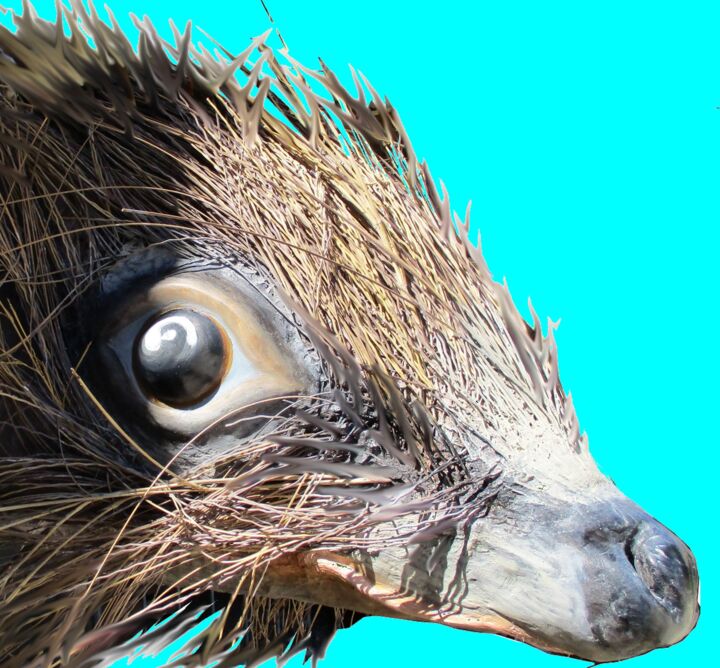
©2019 Applestrophe
Evolutions of theses contemporary works in the art market
As we navigate through the 21st century, the dynamic landscape of contemporary art continues to evolve and expand, reflecting our ever-changing world. Contemporary paintings, once primarily confined to two-dimensional canvases, now embrace a multitude of forms and techniques, ranging from mixed media installations to digital creations, each piece a rich a weaving of thoughts, emotions, and narratives. Sculpture, too, has ventured far beyond traditional stone and bronze, with artists incorporating light, sound, and even motion, embodying the ephemerality and flux of the modern world.
Photography, in the hands of contemporary artists, has expanded its horizons, seamlessly blending with digital technology to create breathtaking imagery that challenges our perception of reality. Drawing, as well, has transcended the borders of paper, incorporating multimedia elements and exploratory techniques to redefine its role in the artistic discourse. Printmaking continues to flourish, with contemporary artists using traditional methods in innovative ways to deliver potent social and personal commentaries.
Textile art, once considered a craft, now holds a prominent place in the contemporary art world, with artists using it to explore issues of identity, tradition, and cultural heritage. Meanwhile, digital art, the newest member of the contemporary art family, has revolutionized the way we create and interact with art, presenting immersive experiences that blur the boundary between the virtual and the physical.
These diverse forms of contemporary art hold significant value in the current art market, not only due to their aesthetic appeal but also their ability to encapsulate and communicate complex ideas and emotions. Collectors, curators, and art lovers worldwide seek these works, drawn to their inherent dynamism, their innovative use of materials, and their eloquent expressions of our shared human experience. As a testimonial to our times, these contemporary artworks encapsulate the pulse of our society and the resonance of individual voices, forever etching our collective narrative into the annals of art history.
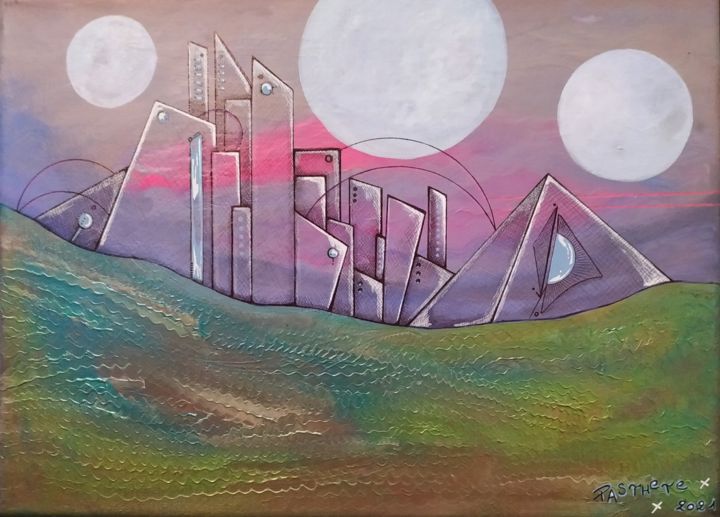
©2021 Pasthete // Salima Woestyn
Famous Contemporary Artists
As we delve into the vibrant realm of contemporary art, we encounter an array of artists who shape this dynamic field. Each a master in their medium - painting, sculpture, photography, drawing, printmaking, textile, or digital art - they push artistic boundaries, reflecting our era and challenging perceptions. Let’s explore these remarkable contributors and their groundbreaking works.
1. Gerhard Richter - Known for his multi-faceted approach to painting, Richter challenges the boundaries of the medium, masterfully oscillating between abstract and photorealistic styles. His works, whether featuring squeegee-pulled pigments or blurred photographic images, engage in a fascinating dialogue with perception.
2. Jeff Koons - A significant figure in contemporary sculpture, Koons crafts monumental pieces that explore themes of consumerism, taste, and popular culture. His iconic balloon animals, constructed in mirror-polished stainless steel, captivate with their playful yet profound commentary.
3. Cindy Sherman - An acclaimed photographer, Sherman uses her lens to explore identity and societal roles, particularly of women. Renowned for her conceptual self-portraits, she assumes myriad characters, pushing the boundaries of photography as a medium of artistic expression.
4. David Hockney - Hockney, with his prolific output spanning six decades, is a pivotal figure in contemporary drawing. His bold use of color and playful exploration of perspective convey an intoxicating sense of joy and an unabashed celebration of life.
5. Kiki Smith - An innovative printmaker, Smith’s work explores the human condition, particularly the female body and its social and cultural connotations. Her etchings and lithographs speak to universal experiences of life, death, and transformation.
6. El Anatsui - A master of textile art, Anatsui creates stunning tapestry-like installations from discarded bottle caps and aluminum scraps. These shimmering, flexible sculptures blend traditional African aesthetic with contemporary art sensibilities, speaking to themes of consumption, waste, and the interconnectedness of our world.
7. Rafael Lozano-Hemmer - A leading figure in digital art, Lozano-Hemmer utilizes technology to create interactive installations that blend architecture and performance art. His work, often participatory in nature, explores themes of surveillance, privacy, and the relationship between people and their environments.
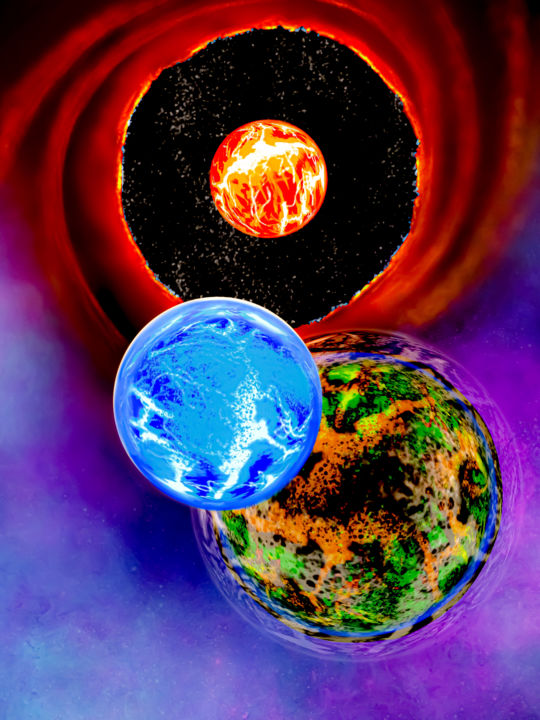
©2020 Keep Magic
Notable contemporary artworks
The contemporary art landscape is a dynamic patchwork of diverse expressions and groundbreaking ideas, each artwork a unique dialog with its audience. Here are a selection of some renowned contemporary artworks, spanning various media such as painting, sculpture, photography, drawing, printmaking, textile art, and digital art, that have profoundly influenced this vibrant movement.
"Cloud Gate" by Anish Kapoor, 2006 - This monumental stainless steel sculpture, also known as "The Bean," mirrors and distorts the Chicago skyline and onlookers in its seamless, liquid-like surface, creating an interactive experience that blurs the line between the artwork and the viewer.
"Marilyn Diptych" by Andy Warhol, 1962 - An iconic piece of pop art, this silkscreen painting features fifty images of Marilyn Monroe. Half brightly colored, half in black and white, it reflects the dichotomy of celebrity life and its influence on popular culture.
"Rhein II" by Andreas Gursky, 1999 - This photographic artwork, a digitally-altered image of the Rhine River, is celebrated for its minimalist aesthetic. It strips the landscape to its bare essentials, invoking a sense of tranquility and vastness.
"Black Square" by Kazimir Malevich, 1915 - A revolutionary painting in the realm of abstract art, this piece, featuring nothing more than a black square on a white field, challenges traditional notions of representation, symbolizing a new era in artistic expression.
"Puppy" by Jeff Koons, 1992 - This giant sculpture, a West Highland Terrier blanketed in flowering plants, explores themes of innocence, consumer culture, and the interplay between high art and kitsch. It’s a delightful blend of traditional sculpture and garden craft.
"Re-projection: Hoerengracht" by Ed and Nancy Kienholz, 1983-1988 - A room-sized tableau representing Amsterdam’s red-light district, this work combines elements of sculpture, painting, lighting, and found objects. It engages viewers in a stark commentary on commodification and objectification.
"Untitled" (Your body is a battleground) by Barbara Kruger, 1989 - This photomontage, combining black-and-white photography with impactful text, explores issues of feminism, identity, and power. Its potent, confrontational message is a prime example of the power of text in contemporary visual art.
"For the Love of God" by Damien Hirst, 2007 - This sculpture, a platinum cast of a human skull encrusted with 8,601 diamonds, probes themes of mortality, value, and the human fascination with luxury and decadence. It’s a compelling blend of macabre and magnificence.
"Physical impossibility of Death in the Mind of Someone Living" by Damien Hirst, 1991 - This artwork, featuring a tiger shark preserved in formaldehyde, blurs the line between traditional sculpture and biological specimen. It prompts viewers to contemplate mortality and nature’s ferocity.
"One and Three Chairs" by Joseph Kosuth, 1965 - A piece of conceptual art, it presents a physical chair, a photograph of a chair, and a dictionary definition of a chair, thus exploring the relationship between language, picture, and referent in art.
These pieces, in their diversity, exemplify the rich tapestry of contemporary art, each piece a unique commentary on our world and a testament to the limitless potential of creative expression.


Keep Magic
Digitale Kunst | 31,5x23,6 in


